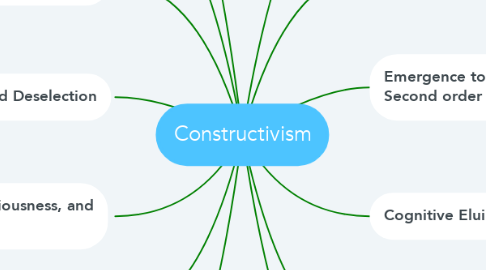Constructivism
Gina Garveyにより


1. Learning Theories
1.1. Behaviorism
1.2. Maturationism
1.3. Constructivism
2. Environmental Equivalence
2.1. evolution
2.2. learning
2.3. organisms create their environment
3. Biological Equilibration
3.1. the process
3.2. new perspectives
3.3. change in environment to survive
4. Dissipative Structures
4.1. cells live, evolve, and flouris
4.2. open system that maintains itself
4.3. produce new forms of order
5. Transition Zones
5.1. bifurcations
5.2. novel structures
6. Emergence to Complex Systems: Second order coupling
6.1. continually create or re-create
6.2. transforming or replacing components
6.3. create their own environment
7. Diversity and Deselection
7.1. bi-directonal
7.2. evolving to more or less complexity
7.3. isolation=entropy
7.4. natural selection
8. Cognitive Eluilibration
8.1. under construction
8.2. self-regulated behavior
8.3. assimilation, interactions between two logical ideas, and differentiation and the integration.
9. Structures
9.1. wholeness
9.2. transformation
9.3. self-regulation
10. Mind, Consciousness, and Language
10.1. spontaneous
10.2. specific
11. Inner Speech
11.1. tool for thinking
11.2. spontaneous concepts
11.2.1. concept-in-itself
11.2.2. concept-for others

